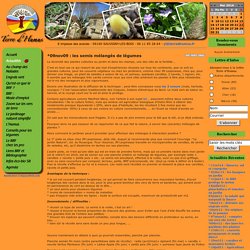

*09nov09 : les semis mélangés de légumes. La diversité des plantes cultivées au jardin et dans les champs, une des clés de la fertilité...

C'est en tout cas ce qui ressort de pas mal d'expériences réussies sur tous les continents, que ce soit en grandes cultures, pour les couverts végétaux ou chez les jardiniers, comme chez JM Lespinasse, chez qui, pour donner une image, un plant de salades a autour de lui, un poireau, quelques carottes, 2 navets, 1 oignon, etc. Il semble que les mélanges très variés comme ceux qui sont cités amènent les plantes à être plus résistantes vis-à-vis des ravageurs et plus vigoureuses. Certains agriculteurs comme Manfred Wenz, voir l'article à son sujet ici , associent même deux cultures simultanées ! On sait que les monocultures sont fragiles. Il n'y a pas de pire ennemi pour le blé que le blé, ai-je déjà entendu ! Alors comment le jardinier peut-il procéder pour effectuer des mélanges à interaction positive ?
Avantages de la technique : Inconvénients / difficultés : * réussir ce type de semis. La milpa. La MILPA : Un exemple indigène d’agro écologie millénaire Il y a environ 6000 ans, les mayas.......

Untitled. Gardening and Permaculture: Companion Planting Chart. Posted on Jan 13, 2012 in Emergency Preparedness & Survival, Urban Gardening, Farming & Homesteading Kevin Hayden – TruthisTreason.net Source: Pioneer Living Companion planting makes use of specific plants as insect repellant and growth stimulators.

The chemical make-up of some plants are simply unattractive to various insects and attractive to certain plant growth. Planting beans near or among potatoes will limit the amount of Colorado potato beetles present. The following chart will help you plan your companion garden to aid in deterring the harmful insects, as well as providing natural growth stimulators for your plants. Companion Plant Spacing. --Download Spacing Calculator Spreadsheet-- --Use Online Spacing Calculator-- Abstract A popular recommendation for determining plant spacing in mixtures does not account for component crop ratios and results in lower total plant density than separate plantings of component crops in pure stands.

This method likely compromises the yield advantage that should be expected from mixed plantings. Companion Planting for Vegetable Patches - Very Edible Gardens. What if everyone around you was exactly like you?

That sounds to me like some kind of perfect hell. Well the first and foremost rule of companion planting is diversity. There are a lot of books written on this subject, filled with long lists, many of which contradict the other. We say don't get too carried away by matching each plant according to someone's list. There are however a some simple rules to grow by. Use plants with different nutrient requirements and roots at different depths as they compete much less. Competition for Nutrients Shallow rooted vegetables include lettuce and bok choy. If all the plants are the same, they are competing for exactly the same nutrients at exactly the same root depths.
Companion Planting / Permaculture Guild Open Map. Companion Plants for Fruit Trees. View topic - Companion plant mindmap. Neckie wrote: Thats great, Im gonna print out a copy for the shed.....

One question. My partner is a scientist and she would ask where is the evidence to back it up. I imagine most of it will be observational, but that raises lots of other questions, eg how far apart do plants need to be to have a plus or minus allelopathy. Are things complicated further if third plant is growing? Have these studies been done in a controlled environment and if not is that something we need to do as permaculturists Most of the information came from various sources on the internet. With the relationships clearly laid out I could work out where to plant what in my garden. Companion Planting - Vegetable Gardening Plant Companions and Combining. Home > Companion gardening Companion planting and combining means growing plants together that like or benefit each other.

Vegetable companion gardening can have a real impact on the health and yield of your plants. In nature everything interacts to create a whole life force. This is a basic understanding... that everything organic and living has a mutual influence on every other living thing. Every plant has an effect on every other plant and every creature has an effect on every other creature. Over time, gardeners have observed these interrelationships, and scientists have studied them. Companion Planting. Some theories about companion planting have been established, and others have had less startling success in scientific trials.

Overall, few cases of beneficial companion planting have been researched well enough to demonstrate true advantages. The lovely little Tagetes patula, or French marigold (actually from Mexico), and its cousins Calendula, have been shown to be invaluable in companion planting. Using mixed plantings in the garden is likely to be beneficial simply because they bring greater balance and a diversity of plants and species, that, in turn, attracts pest predators and avoids the pest-ridden effects of monoculture. Monoculture Monoculture is the planting of rows and rows of the same plants- fields of lettuce, corn and onions, for instance, paradise for a pest or disease that, once introduced, can simply move from plant to plant. Monoculture does not encourage a healthy mixed population of creatures - essential in an organic garden.